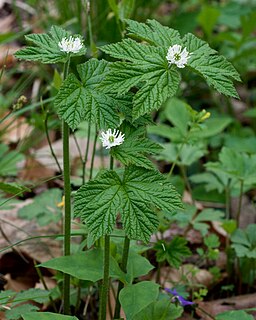
Goldenseal, also called orangeroot or yellow puccoon, is a perennial herb in the buttercup family Ranunculaceae, native to North America. It may be distinguished by its thick, yellow knotted rootstock. The stem is purplish and hairy above ground and yellow below ground where it connects to the yellow rhizome. Goldenseal reproduces both clonally through the rhizome and sexually, with clonal division more frequent than asexual reproduction. It takes between 4 and 5 years for a plant to reach sexual maturity, i.e. the point at which it produces flowers. Plants in the first stage, when the seed erupts and cotyledons emerge, can remain in this state one or more years. The second vegetative stage occurs during years two and three and is characterized by the development of a single leaf and absence of a well developed stem. Finally, the third stage is reproductive, at which point flowering and fruiting occurs. This last stage takes between 4 and 5 years to develop.
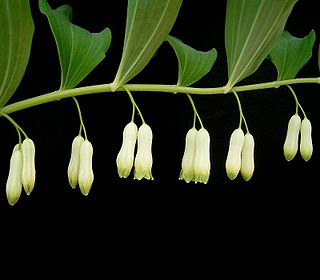
Polygonatum, also known as King Solomon's-seal or Solomon's seal, is a genus of flowering plants. In the APG III classification system, it is placed in the family Asparagaceae, subfamily Nolinoideae. It has also been classified in the former family Convallariaceae and, like many lilioid monocots, was formerly classified in the lily family, Liliaceae. The genus is distributed throughout the temperate Northern Hemisphere. Most of the approximately 63 species occur in Asia, with 20 endemic to China.

Monarda didyma, the crimson beebalm, scarlet beebalm, scarlet monarda, Eau-de-Cologne plant, Oswego tea, or bergamot, is an aromatic herb in the family Lamiaceae, native to eastern North America from Maine west to Ontario and Minnesota, and south to northern Georgia. Its odor is considered similar to that of the bergamot orange. The genus name comes from Nicolas Monardes, who described the first American flora in 1569.
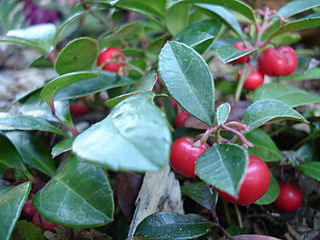
Gaultheria procumbens, also called the eastern teaberry, the checkerberry, the boxberry, or the American wintergreen, is a species of Gaultheria native to northeastern North America from Newfoundland west to southeastern Manitoba, and south to Alabama. It is a member of the Ericaceae.

Podophyllum peltatum is an herbaceous perennial plant in the family Berberidaceae. Its common names are mayapple, American mandrake, wild mandrake, and ground lemon. It is widespread across most of the eastern United States and southeastern Canada.

Maianthemum dilatatum is a common rhizomatous perennial flowering plant that is native to western North America from northern California to the Aleutian islands, and Asia across the Kamchatka Peninsula, Japan, and Korea. It grows in coastal temperate rainforests, and is often the dominant groundcover plant in Sitka Spruce forests.
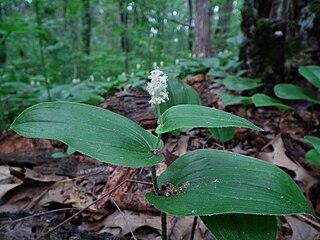
Maianthemum canadense is an understory perennial flowering plant, native to Canada and the north-eastern United States, from Yukon and British Columbia east to Newfoundland, into St. Pierre and Miquelon. It can be found growing in both coniferous and deciduous forests. The plant appears in two forms, either as a single leaf rising from the ground with no fruiting structures or as a flowering/fruiting stem with 2-3 leaves. Flowering shoots have clusters of 12–25 starry-shaped, white flowers held above the leaves.

Maianthemum racemosum, the treacleberry, feathery false lily of the valley, false Solomon's seal, Solomon's plume or false spikenard, is a species of flowering plant native to North America. It is a common, widespread plant with numerous common names and synonyms, known from every US state except Hawaii, and from every Canadian province and territory, as well as from Mexico.
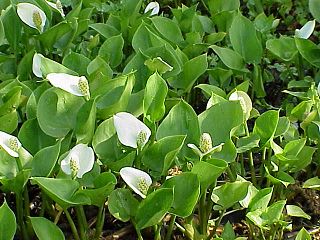
Calla is a genus of flowering plant in the family Araceae, containing the single species Calla palustris.
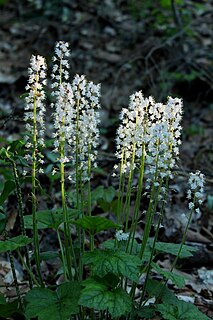
Tiarella cordifolia, the heartleaf foamflower, heartleaved foamflower, Allegheny foamflower, false miterwort, or coolwort, is a species of flowering plant in the saxifrage family, native to North America. It is a herbaceous perennial which is valued in cultivation for its erect stems of foamy cream flowers in summer.

Polygaloides paucifolia, synonym Polygala paucifolia, known as gaywings or fringed polygala, is a perennial plant of the family Polygalaceae.

Apocynum androsaemifolium, the fly-trap dogbane or spreading dogbane, is a flowering plant in the Gentianales order. It is common in North America.
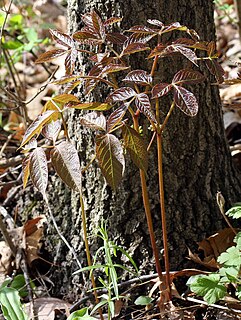
Aralia nudicaulis is a flowering plant of northern and eastern North America which reaches a height of 30–60 cm (12–24 in) with creeping underground stems.

Houstonia caerulea, commonly known as azure bluet, Quaker ladies, or bluets, is a perennial species in the family Rubiaceae. It is native to eastern Canada and the eastern United States. It is found in a variety of habitats such as cliffs, alpine zones, forests, meadows and shores of rivers or lakes.

Mitella diphylla is a clump forming, open woodland plant native to northeast and midwest regions of North America.

Galearis spectabilis, commonly known as showy orchis or showy orchid, is an orchid species of the genus Galearis. It is native to eastern Canada and much of the eastern half of the United States.

Oxalis violacea, the violet wood-sorrel, is a perennial plant and herb in the family Oxalidaceae. Oxalis species are also known as sour grass, sour trefoil, and shamrock.

Streptopus amplexifolius is a species of flowering plant in the family Liliaceae, native to North America, Europe and Asia.

Polygonatum odoratum, the angular Solomon's seal or scented Solomon's seal, is a species of flowering plant in the family Asparagaceae, native to Europe, the Caucasus, Siberia, the Russian Far East, China, Mongolia, Korea and Japan. In the United Kingdom it is one of three native species of the genus, the others being P. multiflorum and P. verticillatum.

Maianthemum stellatum is a species of flowering plant, native across North America. It has been found in northern Mexico, every Canadian province and territory except Nunavut, and from every US state except Hawaii and the states of the Southeast. It has little white buds in the spring, followed by delicate starry flowers, then green-and-black striped berries, and finally deep red berries in the fall.





















